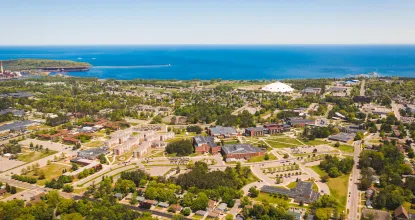Kurt Galbreath
Professor
Contact Information:
2119 Weston Hall
Office Phone: (906) 227-1586
kgalbrea@nmu.edu
Education:
- 2009 - PhD, Evolutionary Biology, Cornell University
- 2002 - MS, Wildlife Biology, University of Alaska Fairbanks
- 1997 - BS, Biology, Illinois Wesleyan University
Research Interests:
I study the diversity and historical biogeography/phylogeography of northern faunas, with a particular focus on parasites and their mammalian hosts across Asia and North America. My research combines museum-based field collections with laboratory-based molecular studies to study the consequences of past environmental perturbations (e.g., climatic cooling and warming) for population demography, diversification, and community assembly.
Teaching:
- BI 221 - Comparative Vertebrate Anatomy
- BI 290 - Pre-vet Seminar
- BI 322 - Vertebrate Zoology
- BI 423 - Parasitology
- BI 520 - Systematics
Publications:
- D Paul, C Thompson, L Arroyo, G Botto Nuñez, I Castro-Arellano, J Colella, J Cook, M Cove, J Dearborn, N de la Sancha, K Derieg, J Dunnum, A Ferguson, K Fitzgerald, C Foat, L Frank, K Galbreath, D Gonzalez, R Hawkins, T Herrera, A Hey, A Hope, A Hornsby, D Ibanez, O Keller, D Krejsa, K Mahoney, J Malaney, M McDonough, T McElrath, V Mathis, T Mayfield-Meyer, I Mosley, N Ordóñez-Garza, K Phelps, R Platt, J Pletcher, H Rinsland, C Rupprecht, K Speer, L Steger, N Upham, R White, B Wiens, L Wooten, P Soltis. 2025. Harnessing natural history collections for collaborative pandemic preparedness. BioScience. biaf035. https://doi.org/10.1093/biosci/biaf035
- B Boldgiv, A Lkhagva, S Edwards, N Stenseth, J Bayarsaikhan, D Altangerel, D Usukhjargal, B Dovchin, S Gombobaatar, N Batsaikhan, C Warinner, I Hart, K Galbreath, S Greiman, J Malaney, J Murdoch, B McLean, S DeWitte, E Manzitto-Tripp, K Chin, T Karim, C Simpson, N Stevens, J Dunnum, J Cook, W Taylor. 2025. Global natural history infrastructure requires international solidarity, support and investment in local capacity: lessons from Mongolia. Proceedings of the National Academy of Sciences. 122:e2411232122. https://doi.org/10.1073/pnas.2411232122
- Z Farrand, K Galbreath, K Teeter. 2024. Evidence of intraspecific adaptive variation in the American pika (Ochotona princeps) on a continental scale using a target enrichment and mitochondrial genome skimming approach. Molecular Ecology. e17557. https://doi.org/10.1111/mec.17557
- B Sjodin, D Schmidt, K Galbreath, M Russello. 2024. Putative climate adaptation in American pikas (Ochotona princeps) is associated with copy number variation across environmental gradients. Scientific Reports. 14:8568. https://doi.org/10.1038/s41598-024-59157-6
- D Schmidt, K Galbreath, M Russello. 2024. Phylogenomics of American pika (Ochotona princeps) lineage diversification. Molecular Phylogenetics and Evolution. 108030. https://doi.org/10.1016/j.ympev.2024.108030
- K Arpin, D Schmidt, B Sjodin, T Einfeldt, K Galbreath, and M Russello. 2024. Evaluating genotyping-in-thousands by sequencing as a genetic monitoring tool for a climate sentinel mammal using non-invasive and archival samples. Ecology and Evolution. 14(2):e10934. https://doi.org/10.1002/ece3.10934
- E Cassidy and K Galbreath. 2023. Consequences of post-glacial contact between phylogroups of Blarina brevicauda in North America’s Great Lakes Region. Journal of Mammalogy. https://doi.org/10.1093/jmammal/gyad058
- K Galbreath, A Makarikov, K Bell, S Greiman, J Allen, G Haas, C Li, J Cook, and E Hoberg. 2023. Late Cenozoic history and the role of Beringia in assembling a Holarctic cestode species complex. Molecular Phylogenetics and Evolution 183:107775. https://doi.org/10.1016/j.ympev.2023.107775
- R Boonstra, N Gandhi, A Kraushaar, and K Galbreath. 2022. From Habitat to Hormones: year-around territorial behavior in rock-dwelling but not in forest and grassland lagomorphs and the role of DHEA. Hormones and Behavior 142: 105179. https://doi.org/10.1016/j.yhbeh.2022.105179
- B Sjodin, K Galbreath, H Lanier, and M Russello. 2021. Chromosome-level reference genome assembly for the American pika (Ochotona princeps). Journal of Heredity. https://doi.org/10.1093/jhered/esab031
- C Anaya, K Galbreath, and M Bolek. 2021. Morphological and molecular characterization of adult hairworms (Phylum Nematomorpha) from Iceland and the Faroe Islands, and documentation of their non-adult stages and hosts. Zootaxa. 4927(2):234–256. doi: 10.11646/zootaxa.4927.2.4
- K Galbreath, H Toman, C Li, and E Hoberg. 2020. When parasites persist: tapeworms survive host extinction and reveal waves of dispersal across Beringia. Proceedings of the Royal Society of London B. https://doi.org/10.1098/rspb.2020.1825
- G Haas, E Hoberg, J Cook, H Henttonen, A Makarikov, S Gallagher, N Dokuchaev, and K Galbreath. 2020. Taxon pulse dynamics, episodic dispersal, and host colonization across Beringia drive diversification of a Holarctic tapeworm assemblage. Journal of Biogeography. 47:2457–2471. https://doi.org/10.1111/jbi.13949
- A Makarikov, K Galbreath, R Eckerlin, and E Hoberg. 2020. Discovery of Arostrilepis tapeworms (Cyclophyllidea: Hymenolepididae) and new insights for parasite species diversity from Eastern North America. Parasitology Research. 119:567–585. https://doi.org/10.1007/s00436-019-06584-4
- A Smith, E Beever, A Kessler, A Johnston, C Ray, C Epps, H Lanier, R Klinger, T Rodhouse, J Varner, J Perrine, A Seglund, E Hall, K Galbreath, et al. 2019. Alternatives to genetic affinity as a context for within-species response to climate. Nature Climate Change 9:787–794. https://doi.org/10.1038/s41558-019-0584-8
- K Galbreath, E Hoberg, J Cook, B Armien, K Bell, M Campbell, J Dunnum, A Dursahinhan, R Eckerlin, S Gardner, S Greiman, H Henttonen, F Jiménez, A Koehler, B Nyamsuren, V Tkach, F Torres-Pérez, A Tsvetkova, and A Hope. 2019. Building an integrated infrastructure for exploring biodiversity: field collections and archives of mammals and parasites. Journal of Mammalogy 100(2):382–393. PDF https://doi.org/10.1093/jmammal/gyz048
- A Rankin, R Schwartz, C Floyd, K Galbreath. 2019. Contrasting consequences of historical climate change for marmots at northern and temperate latitudes. Journal of Mammalogy 100(2):328–344. https://doi.org/10.1093/jmammal/gyz025
- A Rankin, K Galbreath, K Teeter. 2017. Signatures of adaptive molecular evolution in American pika (Ochotona princeps). Journal of Mammalogy 98:1156-1167. https://doi.org/10.1093/jmammal/gyx059
- E Hoberg, J Cook, S Agosta, W Boeger, K Galbreath, S Laaksonen, S Kutz, D Brooks. 2017. Arctic systems in the Quaternary: ecological collision, faunal mosaics and the consequences of a wobbling climate. Journal of Helminthology 91:409-421. https://doi.org/10.1017/S0022149X17000347
- J Cook, K Galbreath, K Bell, M Campbell, S Carrière, J Colella, N Dawson, J Dunnum, R Eckerlin, S Greiman, V Fedorov, G Haas, V Haukisalmi, H Henttonen, A Hope, D Jackson, T Jung, A Koehler, J Kinsella, D Kresja, S Kutz, S Liphardt, S McDonald, J Malaney, A Makarikov, B McLean, R Mulders, N Batsaikhan, S Talbot, V Tkach, A Tsvetkova, H Toman, E Waltari, J Whitman, E Hoberg. 2017. The Beringian Coevolution Project: holistic collections of mammals and associated parasites reveal novel perspectives on evolutionary and environmental change in the North. Arctic Science 3:585-617. https://doi.org/10.1139/AS-2016-0042
- E Hoberg, A Makarikov, V Tkach, S Meagher, T Nims, R Eckerlin, K Galbreath. 2016. Insights on the host associations and geographic distribution of Hymenolepis folkertsi (Cestoda: Hymenolepididae) among rodents across temperate latitudes of North America. Parasitology Research. 115: 4627-4638. doi: 10.1007/s00436-016-5255-3
- H Yuan, J Jiang, A Jiménez, E Hoberg, J Cook, K Galbreath, C Li. 2016. Target gene enrichment in the cyclophyllidean cestodes, the most diverse group of tapeworms. Molecular Ecology Resources. 16:1095-1106. doi: 10.1111/1755-0998.12532
- J Cook, E Lacey, S Ickert-Bond, E Hoberg, K Galbreath, K Bell, S Greiman, B McLean, S Edwards. 2016. From Museum Cases to the Classroom: Emerging Opportunities for Specimen-Based Education. Aspects of Biodiversity; Archives of Zoological Museum of Moscow State University 54: 787-799.
- K Galbreath, E Hoberg. 2015. Host responses to cycles of climate change shape parasite diversity across North America’s Intermountain West. Folia Zoologica. 64:218-232.
- A Makarikov, T Nims, K Galbreath, E Hoberg. 2015. Hymenolepis folkertsi n. sp. (Eucestoda: Hymenolepididae) in the oldfield mouse Peromyscus polionotus (Wagner) (Rodentia: Cricetidae: Neotominae) from the southeastern Nearctic with comments on tapeworm faunal diversity among deer mice. Parasitology Research 114:2107-2117.
- Cook J, Edwards S, Lacey E, Guralnick R, Soltis P, Soltis D, Welch C, Bell K, Galbreath K, Himes C, Allen J, Heath T, Carnaval A, Cooper K, Liu M, Hanken J. 2014. Aiming up: natural history collections as emerging resources for innovative undergraduate education in biology. Bioscience 64:725–734.
- Galbreath K, Ragaliauskaitė K, Kontrimavicius L, Makarikov A, and Hoberg E. 2013. A widespread distribution for Arostrilepis tenuicirrosa (Eucestoda : Hymenolepididae) among arvicoline rodent hosts (Cricetidae) from the Palearctic based on molecular and morphological criteria: historical and biogeographic implications. Acta Parasitologica 58:441–452.
- Hope A, Takebayashi N, Galbreath K, Talbot S, and Cook J. 2013. Temporal, spatial and ecological dynamics of speciation among amphi-Beringian small mammals. Journal of Biogeography 40: 415–429.
- Makarikov A, Galbreath K, and Hoberg E. 2013. Diversity at the Holarctic nexus: species of Arostrilepis (Eucestoda: Hymenolepididae) in arvicoline rodents (Cricetidae: Arvicolinae) from greater Beringia. Zootaxa. 3608:401-439.
- Hoberg E, Galbreath K, Cook J, Kutz S, and Polley L. 2012. Northern host- parasite assemblages: history and biogeography on the borderlands of episodic climate and environmental transition. Advances in Parasitology 79:1-97.
- Galbreath K and Hoberg E. 2012. Return to Beringia: parasites reveal cryptic biogeographic history of North American pikas. Proceedings of the Royal Society of London B. 279:371-378. (Featured in Nature’s Research Highlights, 23 June 2011).
- Galbreath K, Cook J, Eddingsaas A, and DeChaine E. 2011. Diversity and demography in Beringia: multi-locus tests of paleodistribution models reveal complex histories for arctic ground squirrels. Evolution 65:1879-1896.
- Galbreath K, Hafner D, Zamudio K, and Agnew K. 2010. Isolation and introgression in the Intermountain West: contrasting gene genealogies reveal the complex biogeographic history of the American pika (Ochotona princeps). Journal of Biogeography 37:344-362. (Featured on cover)
- Galbreath K, Hafner D, and Zamudio K. 2009. When cold is better: climate-driven elevation shifts yield complex patterns of diversification and demography in an alpine specialist (American pika, Ochotona princeps). Evolution 63:2848-2863. (Featured on cover)
- Hoberg E, Pilitt P, and Galbreath K. 2009. Why museums matter: a tale of pinworms (Oxyuroidea: Heteroxynematidae) among pikas (Ochotona princeps and O. collaris) in the American West. Journal of Parasitology 95:490-501.
Image

